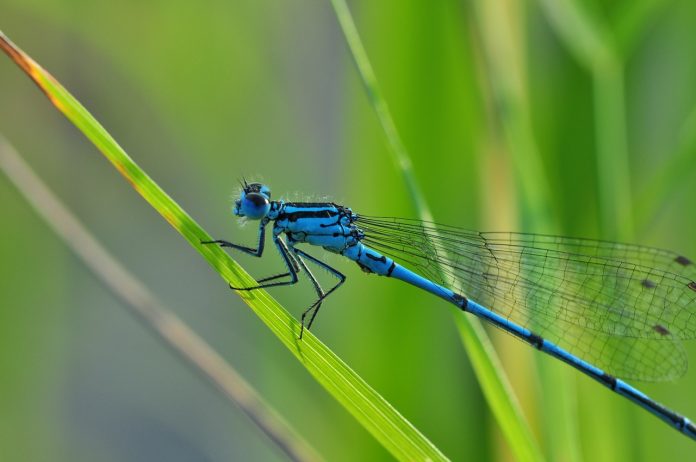Summer is a fascinating season for anyone who enjoys insects. For those who hate mosquitoes, wasps, hornets and flies, not so much.
Today we’ll examine some basic information about these familiar, ubiquitous creatures. Insect numbers peak during warm weather, and they’re easy to find and capture.
What child hasn’t caught a handful of fireflies at dusk and made a living lantern in a peanut butter jar?
Insects
First, let’s review what insects are. They have three body parts — head, thorax, abdomen.
All adults have six legs (spiders have eight legs). Most have two or four wings, but some are wingless. Flies have two wings; butterflies, moths, bees, wasps, dragonflies and damselflies have four wings.
And all insects have two sensory antennae on the head. For example, if you think you’ve seen a “baby” hummingbird in your flower garden, what you’ve really seen is a hummingbird moth.
They hover at nectar-bearing flowers, sip nectar with their uncoiled proboscis, and fly rapidly. But look closely and you’ll notice two distinct antennae on the head.
That’s how you know it’s an insect, not a bird.
Though there are many species of hummingbird moths, you are most likely to see the clearwing hummingbird moth. Its wings become transparent as its scales wear off.
Here are some of the common insects you might encounter over the next eight weeks.
Fireflies
One of my favorite insects, fireflies or lightning bugs, evoke fond memories for anyone raised in the country.
At dusk, they emerge and illuminate the backyard with Morse code-like flashes of light. The darker the night, the more impressive the show. And by the way, these familiar insects are neither flies nor bugs; they’re actually classified as beetles.
Dragonflies
By day, dragonflies and damselflies (members of the order Odonata) patrol the edges of wetlands. They are relatively large and territorial, so they’re easy to observe, especially with binoculars.
Many are brightly colored or conspicuously marked. Sometimes they approach and land on boats that enter their territories.
The basic body plan for odonates includes a large head dominated by huge compound eyes, transparent wings and an elongated abdomen.
Dragonflies have larger, heavier bodies and, at rest, hold their wings flat and perpendicular to the body. Damselflies are slimmer and more delicate and, at rest, fold their wings together above the body.
Odonates are predators that eat other flying insects, including gnats, flies and mosquitoes. They are completely harmless to people. They do not bite or sting.
Crane flies
Some summer insects, such as crane flies, instill more fear than fascination. If you’ve ever encountered what appears to be a giant mosquito under a porch light or even above the kitchen sink, you’ve seen a crane fly.
The body can be an inch long, and their long transparent wings are criss-crossed with a network of veins. Crane flies are harmless; they do not bite or sting.
Adults of many species do not even eat, and those that do, drink nectar.
Butterflies
I’ll close with the Order Lepidoptera, butterflies and moths. Save for a musical ability, they offer everything birds do. Many are brightly colored, and they frequent backyards.
Butterflies are active by day; moths are most active at night. This is one reason many wildlife watchers add butterflies and moths to the list of species they try to attract to their backyards.
Many native wildflowers produce renewable supplies of nectar that attract butterflies. Milkweeds, ironweed, goldenrod, and Joe-Pye-weed are among the best.
Attracting butterflies also means being more tolerant of common “weeds.”
Caterpillars — the much less conspicuous, but usually longer lived larval form of leps — eat the leaves of many backyard weeds. Often in our efforts to create a weed-free yard, we eliminate important caterpillar foods. Caterpillars of commas and question marks, for example, eat stinging nettle leaves; larval painted ladies like thistle; sulphur larva eat clovers; and monarch caterpillars prefer milkweeds.
If we eliminate these “weeds,” we lose the butterflies as well. If the heat gets you down until fall arrives, remember summer is the season for insects.














Have seen this twice. At 30 minuets past sunset, about 8:40 in Alabama tonight, I have seen along with hundreds of fire flies a straight line light flash that looks like a fire fly and flashes like one about 60 feet off ground moving at 45 to 60 miles per hour. Flashes once per second. Travels from a bit south of east to east. Could this be a dragon fly that has caught a fire fly?
Speed is accurate. Flash is white. One light. Straight line of travel. Fire flies are random flashes lower and everywhere.